 | 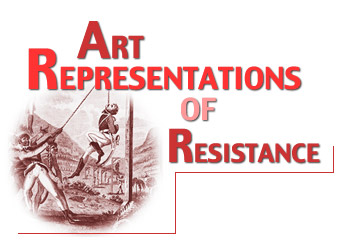
 |
The role of art within society is complex, predominantly due to the many functions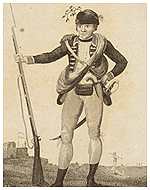 it serves, and through its very existence as a creative process. Yet the contradictions of art allow the historian an insight into a world often inaccessible through text alone. This principle applies to William Hogarth and William Blake, who sought to expose the cultural and social forces at work during their period. The 18th century in Great Britain saw a period of prosperity and exploration encouraged by the economic success of the colonies. However, this success came at a high price - the enslavement of a race, deemed and maintained morally and socially inferior. The acceleration of this enslavement and issues such as humanity and equality in turn generated a new style of interpretation of society and its moral obligation. One manifestation of this came through the work of Blake and Hogarth, who, while both holding very different agendas, encouraged the process of art as a representation of resistance. it serves, and through its very existence as a creative process. Yet the contradictions of art allow the historian an insight into a world often inaccessible through text alone. This principle applies to William Hogarth and William Blake, who sought to expose the cultural and social forces at work during their period. The 18th century in Great Britain saw a period of prosperity and exploration encouraged by the economic success of the colonies. However, this success came at a high price - the enslavement of a race, deemed and maintained morally and socially inferior. The acceleration of this enslavement and issues such as humanity and equality in turn generated a new style of interpretation of society and its moral obligation. One manifestation of this came through the work of Blake and Hogarth, who, while both holding very different agendas, encouraged the process of art as a representation of resistance.
By resistance, in this case, I mean a variety of differing forces – Blake sought to resist the idea of slaves as animals or sub-humans, and fought to contradict many of the ideas held by British society regarding the alleged positive benefits of such a system. Blake’s abolitionism came predominantly through extensive contact with Gabriel Stedman. Hogarth primarily depicted the African slaves of Britain, who had first been imported in the 16th century, and used them to highlight the moral corruption which he believed existed in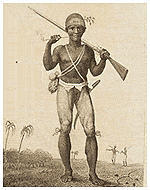 British society. However, in several of his works he makes references to the economic benefits of the slave system and the affect this has on British society. British society. However, in several of his works he makes references to the economic benefits of the slave system and the affect this has on British society.
Controversy surrounds the relationship between Stedman’s book Narratives of a Five Year Expedition and Blake’s engravings. Stedman’s relationship to slavery is itself ambiguous. He went to Surinam as a soldier to surpress a group of rebellious slaves, yet, he fell in love with and had a relationship with a mulatto slave. While he was not the first white man to have a relationship with a slave, the very fact he was unable to liberate both his lover and son had a profound effect on him. In part as a result of this experience, Stedman’s original manuscript was essentially moderately anti-slavery, and often contained vivid descriptions of planter violence. This in turn came to influence Blake, who was commissioned to turn Stedman’s sketches into engravings. However, both Stedman and Blake faced obstacles, which were to ensure that the first edition of the narrative, published in 1796 became decidedly less anti-slavery.
Scholarship on the original manuscript has shown that the publisher attempted to censor the text and direct it in a pro-slavery manner; thus removing much of the horror of the slave reality. Similarly, Blake was restricted by the publisher in his engravings and also indirectly by his artistic style, which veered towards the romantic. As Richard Price shows, Blake often overstepped even the usual barriers between designer and engraver. Such artistic license can be seen in the comparison between the wash drawing by Governor King of ‘A family of New South Wales’, and Blake’s engraving based upon the wash. Price goes onto claim that "Each of Blake’s engravings successfully blends his own inner vision with Stedman’s, producing works that express,…, extraordinary power and pathos."
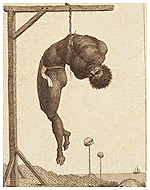 Blake’s images often portrayed horrifically violent events, and were made all the more shocking by his romantic style. The Execution of Breaking on the Rack allows the audience to understand the punishment of slaves, as manifested here through a style of execution. Blake challenges the audience to justify such horror through the victim’s lifeless eyes and through the facial expression of the other slave. Blake perhaps saw a lack of clothes as a representation of the slaves’ purity and their closeness to nature. But, the placement of the axe and the severed hand in the foreground of the picture immediately allow the audience to understand the levels of barbarity employed. Similarly, the slave on the Rack has assumed an almost Christ-like position – the rack representative of the cross, while the large eyes of the slave follow a similar pattern to Western depictions of Christ. Blake may or may not intend to compare the slave to Christ, but he clearly asks the audience to question whether the products of the colonies are more valuable than a human life. Similarly, this image follows Blake’s occasionally radical tendency to place the scared and the sinful side by side. Blake’s images often portrayed horrifically violent events, and were made all the more shocking by his romantic style. The Execution of Breaking on the Rack allows the audience to understand the punishment of slaves, as manifested here through a style of execution. Blake challenges the audience to justify such horror through the victim’s lifeless eyes and through the facial expression of the other slave. Blake perhaps saw a lack of clothes as a representation of the slaves’ purity and their closeness to nature. But, the placement of the axe and the severed hand in the foreground of the picture immediately allow the audience to understand the levels of barbarity employed. Similarly, the slave on the Rack has assumed an almost Christ-like position – the rack representative of the cross, while the large eyes of the slave follow a similar pattern to Western depictions of Christ. Blake may or may not intend to compare the slave to Christ, but he clearly asks the audience to question whether the products of the colonies are more valuable than a human life. Similarly, this image follows Blake’s occasionally radical tendency to place the scared and the sinful side by side.
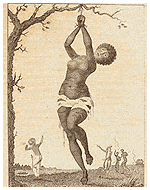 Blake’s horror at the treatment of slaves again manifests itself in The Flagellation of a Female Samboe Slave. The woman is placed in the foreground of picture and therefore provides a visually arresting image of anguish and pain. Her features are Europeanized, indicating her mixed heritage, but also allowing the audience a degree of connection. People are often more responsive to people and objects with which they feel most familiar. Her helplessness is clearly indicated through her bound hands and torn clothing. The presence of both slaves and soldiers in the background highlights the complicity between both parties in the punishment of female slaves. In this image, the slave has become the epitome of the noble savage, for any audience would be unlikely to condone such violence upon the fairer sex. He hallows the sanctity of the female form and the female persona – pointing to radical ideas of strong similarities in the way women must be treated, regardless of race. Blake’s horror at the treatment of slaves again manifests itself in The Flagellation of a Female Samboe Slave. The woman is placed in the foreground of picture and therefore provides a visually arresting image of anguish and pain. Her features are Europeanized, indicating her mixed heritage, but also allowing the audience a degree of connection. People are often more responsive to people and objects with which they feel most familiar. Her helplessness is clearly indicated through her bound hands and torn clothing. The presence of both slaves and soldiers in the background highlights the complicity between both parties in the punishment of female slaves. In this image, the slave has become the epitome of the noble savage, for any audience would be unlikely to condone such violence upon the fairer sex. He hallows the sanctity of the female form and the female persona – pointing to radical ideas of strong similarities in the way women must be treated, regardless of race.
The final image is Europe supported by Africa and America – commentary on the image is divided over the actual sense Blake was trying to convey here as it is believed Stedman’s original sketch differed quite considerably. Here Blake has depicted three equally sensual women, with Europe being supported by America and Africa. While Europe remains the superior of the three, Blake applied the same stylistic principles to all three portraits. The interdependence shows through the linking of arms amongst the three women and the braid, which perhaps represents tobacco, and binds them together. His engraving promotes the image that without Africa and America, Europe is unsupported – therefore, Europe must question the treatment of Africa and America in this cycle.
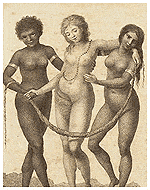
In conclusion, Blake’s resistance is clear – he wished to demonstrate through art the negative aspects of slavery. While he does not go so far as to denounce the institution, he does force the audience to question it. He illustrates, through these three examples, the importance of fair exchange and treatment – a balance in this area would lead to a better deal for all involved. He also examines the worth of slavery through his portrayal of punishment – subconsciously allowing the audience to examine how much the products of the colonies are worth if they come with so much pain and torment. This can also be balanced with the idea that Blake sought to emphasis the humanity of the slaves. Contradictions exist within every artist’s work, and Blake in fact courted contradiction. Thus the task of the historian becomes one of balancing his work with historical text surrounding both the subject matter itself and critiques of his work.
In contrast, Hogarth approaches the issue of slaves in a very different manner, as he is essentially a social satirist. Hogarth believed that moral corruption, social mobility and self-satisfaction were two key contemporary social diseases, which needed addressing. He claimed that repudiation of one’s natural class is an act leading to loss of innocence and ultimate catastrophe; but social mobility could be achieved through basic hard work.
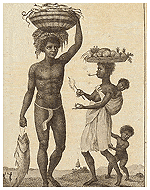 African slaves had been introduced to Britain in the 16th century, although most had always been domestic servants, rather than the field laborers so essential to Britain’s colonies. Hogarth however, maintained a primarily ambivalent attitude towards slavery. In his art, he uses slaves as objects, to highlight the satire of a certain scene. But, if one compares his work to that of his contemporaries, his depictions take on a far more radical air. Artists such as Daindridge in Young Girl with Dog and Negro Boy depicted blacks with animal like characteristics, who apart from basic physical form were virtually indistinguishable from the stance and position of pets. In contrast, Hogarth applied far more humanistic methods to his depiction of slaves. In his manuscript, Analysis of Beauty, Hogarth discusses the importance of skin tone – in contemporary Britain a commonly held idea was that all blacks had the same monotonous skin color. Hogarth believed that ‘the fair young girl, the brown old man and the Negro; nay all mankind, have the same appearance, and are alike disagreeable to the eye, when the upper skin is taken away.’ This belief was further translated in his work as he sought to differentiate skin tone and features in manner previously only applied to white subjects. Indeed, in contrast to many of his contemporaries, ‘The blacks in Hogarth’s work though amount to more than an erudite nod at artistic conventions; they are very much part of the narrative of his paintings and prints.’ African slaves had been introduced to Britain in the 16th century, although most had always been domestic servants, rather than the field laborers so essential to Britain’s colonies. Hogarth however, maintained a primarily ambivalent attitude towards slavery. In his art, he uses slaves as objects, to highlight the satire of a certain scene. But, if one compares his work to that of his contemporaries, his depictions take on a far more radical air. Artists such as Daindridge in Young Girl with Dog and Negro Boy depicted blacks with animal like characteristics, who apart from basic physical form were virtually indistinguishable from the stance and position of pets. In contrast, Hogarth applied far more humanistic methods to his depiction of slaves. In his manuscript, Analysis of Beauty, Hogarth discusses the importance of skin tone – in contemporary Britain a commonly held idea was that all blacks had the same monotonous skin color. Hogarth believed that ‘the fair young girl, the brown old man and the Negro; nay all mankind, have the same appearance, and are alike disagreeable to the eye, when the upper skin is taken away.’ This belief was further translated in his work as he sought to differentiate skin tone and features in manner previously only applied to white subjects. Indeed, in contrast to many of his contemporaries, ‘The blacks in Hogarth’s work though amount to more than an erudite nod at artistic conventions; they are very much part of the narrative of his paintings and prints.’
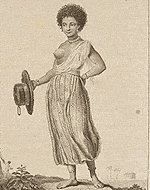 The African appears in Hogarth’s Harlot’s Progress in two separate plates, and subsequently plays two differing roles. The narrative tells of Moll Hackabout, a country girl who comes to the city in search of work. Gradually the city begins to create a process of moral and physical demise, ending in her death. The predominant theme is one of slavery however, in this case, the enslavement of Moll into a life of prostitution. Hogarth uses the African houseboy in Plate 2 to symbolize this enslavement of Moll. He carries a teapot, which serves as a direct reference to the colonies, as does the presence of the monkey on the floor. Dabydeen claims that the presence of the African emphasis the connection between the merchant who patronizes Moll using money he made from colonial trade, money that encourages the growth of prostitution in England. This cyclical nature creates an overall theme for the plate. The African symbolizes Moll’s future; both are dressed in fine clothes and live in a comfortable environment yet both are enslaved. Hogarth juxtaposes this enslavement with the presence of religious images on the walls and an overall atmosphere of finery and gentility. This contains a further message – class and style are, as was common, based on a cruel institution, namely slave labor in the colonies. The African appears in Hogarth’s Harlot’s Progress in two separate plates, and subsequently plays two differing roles. The narrative tells of Moll Hackabout, a country girl who comes to the city in search of work. Gradually the city begins to create a process of moral and physical demise, ending in her death. The predominant theme is one of slavery however, in this case, the enslavement of Moll into a life of prostitution. Hogarth uses the African houseboy in Plate 2 to symbolize this enslavement of Moll. He carries a teapot, which serves as a direct reference to the colonies, as does the presence of the monkey on the floor. Dabydeen claims that the presence of the African emphasis the connection between the merchant who patronizes Moll using money he made from colonial trade, money that encourages the growth of prostitution in England. This cyclical nature creates an overall theme for the plate. The African symbolizes Moll’s future; both are dressed in fine clothes and live in a comfortable environment yet both are enslaved. Hogarth juxtaposes this enslavement with the presence of religious images on the walls and an overall atmosphere of finery and gentility. This contains a further message – class and style are, as was common, based on a cruel institution, namely slave labor in the colonies.
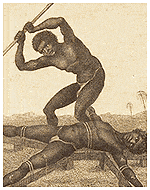 A black women appears in the Plate 4, the scene in which Moll is in prison, and is again used in a similar cyclical manner. Her presence highlights to the viewer the position Moll has now reached – a prisoner with no civil rights, a predicament at close proximity to the slaves in the colonies. The woman’s pregnancy creates the idea of continued exploitation, as her unborn child will become a slave. Likewise, Dabydeen sees another link to Moll, as many female prisoners were transported to the colonies as potential wives of planters – serving the same sexual and economic purpose as the African female slave. The exploitation seems continual, with each area feeding the sustention of another. The African woman also comes to represent what Moll will soon look like – hunched over and weary, worn out by the hardship of life. The African in the Harlot’s Progress was represented in a sympathetic light; Hogarth’s compassion and desire to humanize and equalize the experience is very real. The demise of Moll illustrates how close blacks and whites are the perceived moral scale of the period – for Hogarth is claiming that whites can very easily wind up at the same low social strata as blacks. A black women appears in the Plate 4, the scene in which Moll is in prison, and is again used in a similar cyclical manner. Her presence highlights to the viewer the position Moll has now reached – a prisoner with no civil rights, a predicament at close proximity to the slaves in the colonies. The woman’s pregnancy creates the idea of continued exploitation, as her unborn child will become a slave. Likewise, Dabydeen sees another link to Moll, as many female prisoners were transported to the colonies as potential wives of planters – serving the same sexual and economic purpose as the African female slave. The exploitation seems continual, with each area feeding the sustention of another. The African woman also comes to represent what Moll will soon look like – hunched over and weary, worn out by the hardship of life. The African in the Harlot’s Progress was represented in a sympathetic light; Hogarth’s compassion and desire to humanize and equalize the experience is very real. The demise of Moll illustrates how close blacks and whites are the perceived moral scale of the period – for Hogarth is claiming that whites can very easily wind up at the same low social strata as blacks.
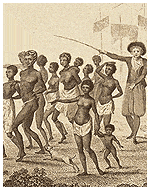 The desire to expose moral corruption and hypocrisy appears in The Four Times of Day – Morning. A black beggar woman with her hand outstretched confronts the pious white woman on her way to church. The white woman here is seen to represent the civilized classes, those whose moral and religious tone is high. However, she makes a mockery of such Christian principles as she chooses to ignore the hand. In this Hogarth throws into question the very basis the hypocritical society that allowed the establishment of slavery. Christianity was used as a basis for slavery, with the conversion of the barbarians as the key element. The white woman’s disregard shows how shallow this justification is – she brought the African here yet is not willing to help her. The positioning of the figures is also important. Hogarth seems to be mocking the upright, aloof stance of the white by placing her next to the huddled masses around the fire. The African here is obviously cold, and Hogarth seeks to show what an alien environment it is for her. The key message seems to be an examination of the basis of slavery. He throws into question its justification, and points to the African beggar as an example of this question. She is repressed and an outsider, thus has little chance of social mobility. The superior position of the white woman highlights the perpetrator of such action. The desire to expose moral corruption and hypocrisy appears in The Four Times of Day – Morning. A black beggar woman with her hand outstretched confronts the pious white woman on her way to church. The white woman here is seen to represent the civilized classes, those whose moral and religious tone is high. However, she makes a mockery of such Christian principles as she chooses to ignore the hand. In this Hogarth throws into question the very basis the hypocritical society that allowed the establishment of slavery. Christianity was used as a basis for slavery, with the conversion of the barbarians as the key element. The white woman’s disregard shows how shallow this justification is – she brought the African here yet is not willing to help her. The positioning of the figures is also important. Hogarth seems to be mocking the upright, aloof stance of the white by placing her next to the huddled masses around the fire. The African here is obviously cold, and Hogarth seeks to show what an alien environment it is for her. The key message seems to be an examination of the basis of slavery. He throws into question its justification, and points to the African beggar as an example of this question. She is repressed and an outsider, thus has little chance of social mobility. The superior position of the white woman highlights the perpetrator of such action.
In conclusion, Hogarth used the African to call into question the foundation of British and colonial society. He highlighted the moral corruption, that took place under the establishment of the colonies and slavery – and the consequences this new found wealth had on British society. An increase in prostitution, lack of concern about a fellow man and the disrespect caused to Christianity through this basic hypocrisy were all secondary products of slavery. Hogarth called for his audience to find a sense of their moral obligation.
|
Stedman was the author of ‘Narrative, of a five years’ expedition, against the revolted Negroes of Surinam, in Guiana, on the wild coast of South America; from the year 1772 to 1777: elucidating the history of that country and describing its productions …with an account of the Indians of Guiana and Negroes of Guinea.’ London, J.Johnson, 1796
Price, Richard. Representations of slavery: John Gabriel Stedman’s "Minnesota" manuscripts.
Edited by Richard Price and Sally Price. Narrative of a five years’ expedition against the revolted Negroes of Surinam. Selections. Stedman’s Surinam: life in eighteenth –century slave society.
D. Dabydeen. Analysis of Beauty quoted in Hogarth’s Blacks. Images of Blacks in Eighteenth Century English Art.
D. Dabydeen. Hogarth’s Blacks. Images of Blacks in Eighteenth Century English Art.
|

 |





